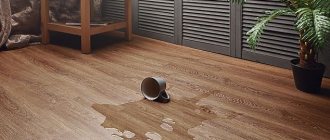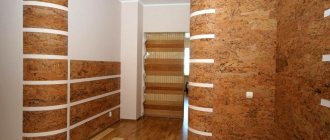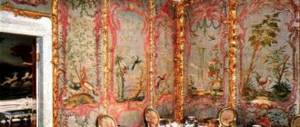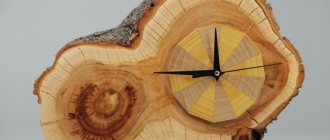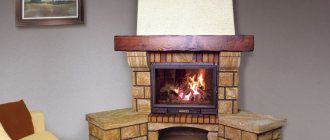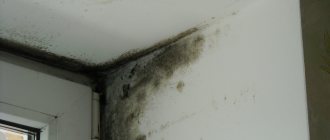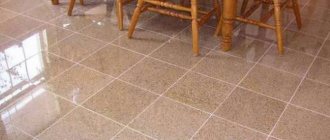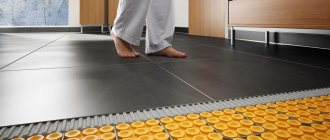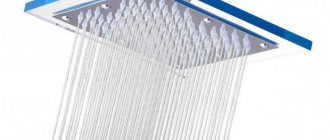Ceramic tile
Ceramic tiles are the most popular material used for finishing walls in rooms with high humidity levels. It is very diverse, easy to care for and not susceptible to moisture.
The tile does not fade, does not change color or shape, thereby retaining its decorative properties. However, cladding with this material requires careful preliminary preparation of the surface. In addition, only a qualified craftsman can lay the tiles correctly. Without the proper skills, laying tiles yourself will be very difficult.
The modern choice of ceramic tiles is quite large. You can verify this by examining the collections of ceramic tiles on the website. Based on the type of glaze, it is divided into transparent and matte. The first, in turn, is divided into glossy and semi-polished. The glaze protects the top layer of ceramic. It can imitate the structure of wood or other material, be artificially aged or simply smooth. Currently, porcelain tiles and clinker, which is a variation of the same ceramic tiles, are also popular. This is a more durable material, practically unaffected by moisture, which is why clinker steps are used for finishing outdoor stairs in any climate zone.
What features does the material have?
To lay porcelain tiles on walls, you must first prepare the surface; it must be completely free of cracks. The coatings that were previously present on the walls are removed in full, then you need to see what condition the lower part is in. Glue with an epoxy base will help to cope with minor defects and create an additional layer responsible for waterproofing. To solve this problem, you can also purchase ordinary cement mortars and putty with high resistance to moisture. At the same time, too wet walls cannot be used as a base; the maximum permissible level is 3 percent.
Porcelain tiles in the bathroom interior
What materials are suitable as putty? Any variety is acceptable, especially with cement and antihydrite additives. They are applied in one layer with a width of no more than 2 millimeters. We apply a layer of primer on top so that the surfaces adhere better to each other. The primer emulsion will penetrate into all layers of the base. The surface must be smoothed even before the entire finish dries completely.
When the surface is ready, we begin to make markings. We’ll look at how to drill porcelain tiles a little later. Marking is needed in order to determine exactly where the masonry begins. And where you need to trim the material. Laying tiles inside begins from the side that is furthest away. As far as pruning goes, it usually comes down to the doors. First you need to lay out the bottom row, then it will be easier to imagine the final appearance of the room and calculate the required amount of materials.
Preparing the solution
A regular adhesive mixture is not enough to hold the tiles on the surface. We will need a special composition with the addition of polymer components. It is important to check with the sellers in advance whether the mixture is suitable for attaching porcelain tiles to the bathroom walls. Inside there are instructions from the manufacturer, you must strictly follow them. The compositions are used only in liquid form.
Let's move on to the installation process
We are guided by the following basic rules:
- The room temperature should be in the range from +10 to +40 degrees. The humidity level in a room increases when the temperature level becomes lower.
- The solution is applied not only to the walls themselves, but also to the tiles in a thin layer.
- There must be a certain number of seams between the plates. They will help to provide for possible expansions within the structure; tile crosses determine the accuracy of each gap.
- Thin layers begin to set quickly, so it is better to apply the composition to small surface areas.
Porcelain tiles in the bathroom interior
Apply the solution using comb spatulas. You need to choose the right height of the teeth; it depends on the size of the tile that a particular person is working with. The larger the sizes used in practice, the larger the teeth we will need. For example, a spatula measuring 8 mm is suitable for tiles 20 by 20; spatulas from 12-15 mm are required with tiles 30 by 30. The layer is applied no less than 2 mm, but no more
Voids and problems are unacceptable, otherwise the tile may simply split and crack.
You need to start laying from the bottom of the room, then move upstairs. Is it possible to put porcelain tiles on the walls in the bathroom? Yes, it is important to correctly apply it to the solution, and then press it for a while. If the tile is large, it is recommended to tap it with a rubber hammer so that it adheres better to the base.
The slabs of the bottom row always come first. You need to wait until they set, not forgetting about the seams. Horizontal evenness is the factor by which each tile is checked. It is important to ensure that there are no differences; this can be easily checked using a special plumb line. The guideline for the top edge is a rope, which is stretched along the entire perimeter of the room, then it will be easier to maintain accuracy in relation to the top row.
Adjacent tiles should butt together at their edges. After this, everything is applied to the wall, moving towards the nearest tiles with slight pressure. The grooves are carefully calculated and crosses are installed in them.
Bathroom interior design with porcelain stoneware
The tiles are laid on top of those parts that have had time to dry. The cladding of the walls is no different from the masonry below; the mortar is laid according to the standard pattern. The crosses are placed almost immediately, after which the tiles are pressed firmly. They fall down on their own after some time; all that remains is to check how well the seams match and how even the horizontal position remains. We begin trimming only after the solution has dried and the main part of the tile is in place.
Separately in each case, measure each part for trimming. A tile cutter will help you cut off the excess.
At the last stage, the seams are sealed using the so-called fugue. But you need to wait until the solution is completely dry. It is recommended to leave it on for at least half a day. It is recommended to grout the seams on the surface of clean tiles, then the remaining mortar will not affect the color of the fugue and will not clog into the seams themselves. A sponge or rubber spatula are the most suitable tools in this case. Porcelain tiles are easy to clean with regular cleaning products when the work is finished.
Mosaic
An excellent option for decorating the interior of any room with high humidity is wall cladding with mosaics. Mosaic is a panel or ornament made from multi-colored particles of glass, ceramics or metal.
You can choose mosaics for the bathroom in different shades, sizes and from different manufacturers. Attaching mosaic panels is not difficult and there are several different ways.
Glass mosaic tiles are supplied ready-made for ease of installation - tile chips (squares) are assembled in modules. They are applied to thick paper, and after gluing them to the surface, the paper layer is washed off. Mosaic tiles on a polymer mesh are mounted directly on the wall. This method is ideal for covering various protrusions and other rounded surfaces, and buying bathroom mosaics on a mesh makes sense in this case.
Adhesive consumption for porcelain tiles
Adhesive consumption for porcelain tiles
The amount of glue required for laying porcelain tiles is calculated taking into account the consumption per square meter.
For correct calculations, you need to decide on the type of mixture.
The consumption of compositions based on cement, as a rule, ranges from 1-2 kilograms per square with a thickness of a millimeter.
In addition, the size of the tile matters. The larger it is, the thicker the adhesive layer should be. For small square tiles, it will be enough to lay a layer of two millimeters. If the tile has dimensions of 30x30 or 50x50, the layer thickness will be from three to four millimeters. If the tiles are larger, the thickness of the adhesive layer for porcelain tiles will be already four to five millimeters.
These are all approximate figures.
The quantity also depends on the size of the spatula. So, for tiles with a side of 30, a spatula of 8 is used, while the layer in millimeters is not indicated on the packaging at all. The thing is that it is impossible to determine the thickness of the adhesive layer. You can apply the glue evenly, but if there are differences in height on the surface, air holes will appear during installation.
As a result, over time, the tiles will begin to peel off from the surface. Therefore, the mixture is first applied using the flat end of a spatula, after which it is worked with a serrated edge.
It is very important to carefully prepare the surface on which porcelain stoneware will be laid. It should be perfectly smooth. In this case, the glue can be applied in a thin layer. At the same time, it provides reliable adhesion between the tile and the surface. The adhesive composition for thick-layer installation not only bonds the tiles to the base, but also levels it.
The layer can be up to thirty millimeters; accordingly, the consumption of glue for porcelain tiles increases.
Mirror panels
Mirror plates make the interior very spacious and modern. The material used for their manufacture is frosted or tinted moisture-resistant mirror glass.
The plates are thin (4-6 mm) panels. They can cover all surfaces of the walls of the room or part of them. This material visually increases the space and makes the room brighter, as it has the ability to reflect rays.
If you decide to use this material for decoration in the bathroom, then you should keep in mind that silver amalgam is more durable and durable than aluminum, and polished chips, unlike bevel, do not distort the image.
An additional difficulty is that before laying the mirror panels it will be necessary to remove all old coatings and plaster down to the concrete or brick base. This is necessary to create a perfectly flat wall surface. Otherwise, the space of the room will be greatly distorted by the mirror panels. As an option, you can buy a mosaic for a mirror-type bathroom. In this case, manufacturers offer chips of various shapes:
- round;
- square;
- diamond-shaped.
The sizes are also different and range from 10x10 mm to 150x150 mm.
Porcelain tiles for bathroom floors and walls
Basically, the walls are decorated with polished or glazed porcelain tiles. It perfectly reflects light and expands the space in small rooms.
The well-known postulate that how many people, so many opinions, speaks for itself. There are a huge number of porcelain stoneware manufacturing plants. The quality of the products also varies greatly.
Accordingly, there is no consensus on this or that product either. Some people like to work with Russian materials, such as Italon Charme Extra tiles, some prefer European materials, and others choose Ukrainian ones. Therefore, we will simply consider the products that are most in demand on the Russian market.
Kerama Marazzj
More than 2000 titles have been developed - these are 12 collections of the Russian manufacturer. The only brand in the production of which European DRY PRESS technologies are used. This allows you to accurately style natural stone.
We recommend: Nobo heating equipment
Positive traits:
- Relatively inexpensive cost,
- Good geometry, cuts well,
- Stylish, attractive design solutions,
- Rated as quite durable, resistant to mechanical shock.
Disadvantages: sometimes in collections the combination of colors or shades is poorly selected, there are deviations in length.
Fap Ceramiche
Expensive elite Italian porcelain tiles. It has been produced for many years at a plant in the city of Sassuolo, which naturally speaks of the quality of the material produced.
Designers have created almost 30 collections, the main emphasis being safety and environmental friendliness. The surface pattern is created to resemble natural stone, marble, wood.
Advantages:
- Excellent design solutions,
- Solid choice
- Quality products,
- Resistant to mechanical damage,
- The appearance is very respectable,
- Cuts well.
Among the shortcomings, it can be noted that sometimes the geometry of the elements is “lame”, there are deviations in size. Prices are quite high for the average consumer.
Keramin
Belarusian porcelain stoneware is created at the Minsk brick factory. More than 80 collections were released. Relatively low price, size range from 10x10 to 27.5x40 cm. In general, the quality is in accordance with the cost.
Pros:
- Large thematic selection,
- Interesting design patterns on the surface,
- High quality, durable products,
- Availability of interesting collections,
- Cuts well.
But: sometimes in collections there are discrepancies on the side of the tile of 1-2 mm, deviations in width and length.
We recommend: Why laminate flooring swells, how to fix it
Golden Tile
Ukrainian porcelain tiles from the Kharkov plant. The enterprise has organized the Italian bureau SRS, Poligraph, Tecnografica. More than 60 collections have been developed. The plant uses the latest special technologies for digital printing on surfaces.
The cost is low or medium - depends on the selected collection. In one batch there are discrepancies in penumbra or shades. Dimensional discrepancies are common.
Positive traits:
- The quality of porcelain tiles corresponds to the price (local raw materials are used),
- Wide choose,
- Great job from the designers.
Disadvantages: deviations on the side, there is a discrepancy in shades between different batches of the same collection.
PVC and MDF panels
Even simpler materials for decoration are MDF and PVC panels. This is also the cheapest finishing option. It does not even require careful leveling of the wall surface.
Due to their ease of installation, the panels are very popular among consumers. However, there are some peculiarities here too. So the walls must be dry enough. Otherwise, fungus will grow under the finish.
Algaecide preparations can be used as an additional preventative measure. PVC and MDF panels can have a variety of colors and shades, and they are attached to the sheathing.
Hardboard
When talking about finishing panels for the bathroom, one cannot fail to mention decorated hardboard. Its base is eucalyptus fiber. To cover them, a transparent melamine laminate is used. They produce decorative hardboard in the form of square tiles of various sizes.
Of course, if your design project uses natural and valuable materials to decorate your apartment, it would be more appropriate to buy a mosaic for the bathroom.
If we talk about full compliance with the technology of covering walls with various panels, then we should also mention the need for preliminary cladding with gypsum fiber boards, which have high moisture resistance. Another option could be a frame made of timber, built in increments of 40 cm. When fastening the panels vertically, the timber is placed horizontally, and vice versa, if the panels are fastened horizontally, then the beam should have a vertical direction. If a frame is used, it must be treated with a water-repellent compound. Although the grooves along the edges of the panels protect the interior from moisture.
Composition of adhesive for porcelain tiles
To work with porcelain stoneware, you cannot do without a special glue, since simple tile compounds and cement cannot be used. Porcelain tiles have low water absorption; therefore, it is not recommended to lay them on either inexpensive glue or a sand-cement mixture. This is due to the fact that the surface of porcelain stoneware does not absorb the adhesive cement laitance, as a result, voids remain under the slabs, and the material “walks” along the wall.
To solve this problem, manufacturers offer special formulations. In stores they are sold in packages with the appropriate mark. It may be written that the composition is recommended for porcelain tiles, as well as artificial and natural stone. They are packaged in dry form, similar to powdered construction mixture and require dilution with water.
The composition of the adhesive for porcelain tiles is based on cement.
Various artificial resins, mineral plasticizers, and additives are added to it, which give the glue special properties: adhesive strength, plasticity, resistance to temperature fluctuations. Modern compositions are environmentally friendly and do not contain components or asbestos fibers hazardous to human health.
The high-quality composition can be applied to brick, concrete, plasterboard, cement screeds and other substrates.
The higher the adhesive properties of the glue, the more securely the tile will be attached. If we are talking about large, heavy tiles, then you cannot do without a high-quality composition with high adhesion.
Where is frost-resistant adhesive for porcelain tiles used?
When purchasing glue, special attention is paid to its resistance to temperature changes if the tiles need to be laid outside, for example, to finish a base or facade.
Wood
Another type of wall covering in the bathroom is wood. As a rule, it is used to cover only a third of the surface. Then this decoration takes the form of a border.
It is clear that for these purposes you should use wood that has good moisture resistance (larch, merabou, hevea).
Despite this, the panels still need to be treated with a composition that protects against moisture, and also varnished. In addition, you can now buy bathroom mosaics made of wood, bamboo and coconut. This will help add an exotic touch to your interior.
Painting the walls
An even more traditional, but increasingly less used method of finishing walls is decorating them by painting them. However, this method seems simple only at first glance. In fact, here it is necessary to level the walls very well. The requirements for the applied layer of paint are also special. It must be durable, non-toxic, moisture-resistant, and have dirt-repellent properties.
To protect against fungus, fungicides are added to the coloring composition. However, there should not be a strong smell from the paint. Latex and acrylic paints meet all these requirements. Just keep in mind that oil-based putties can significantly discolor the paint applied to them.
In this regard, it is better to cover the walls in the bathroom with moisture-resistant water-based compounds, ceramic tiles or glass mosaics.
Now, having all this knowledge, you can choose the right material for your room!
ShareLikeClass TweetPinSubscribeWhatsappTelegram
What is porcelain tile
Most often, porcelain stoneware can be found today on the walls of buildings or in interior decoration. In essence, it is a tile of a certain size with a smooth glossy surface. But unlike simple ceramics, it has a pronounced stone structure; it can be granite of various colors or even marble with characteristic veins. Of course, marble walls look rich and solid, but in nature this stone is very fragile, and any harder object can scratch it. In addition, the process of mining and processing natural stone is very complex; it is one thing to simply mine the rock, and quite another to saw it into even slabs and polish it to a glossy shine. That is why the technology for the production of porcelain stoneware was developed; this material not only received higher quality characteristics, but also the price was significantly reduced compared to natural analogues.
Essentially, these are tiles of a certain size with a smooth glossy surface.
How porcelain tiles are produced
The whole process differs little from the production of simple ceramic tiles, with the only difference being that a large percentage of granite chips are added to the red clay; it is this that gives the texture characteristic of natural stone. The proportional ratio of granite and ceramics differs from one manufacturer to another, which quite often affects the final cost of the product. The initial firing results in a monolithic slab that looks like stone but has the strength of ceramic. It is the percentage ratio of clay to stone chips that affects the final quality. Since ceramics are fired at a temperature of 900 degrees, granite does not enter into any reactions and serves only as a binder and decorative component. The more it is in the composition, the more beautiful the product is, but the lower its technical characteristics. After the initial firing, the porcelain stoneware slab is covered with glaze and sent back to the kiln, where already at a temperature of 1100-1400 degrees the top coating melts and turns into glass. Thus, the result is a glossy, perfectly smooth slab that looks like natural granite.
Related article: Do-it-yourself partitions made of aerated concrete blocks
Thus, the result is a glossy, perfectly smooth slab that looks like natural granite.
Pros and cons of porcelain tiles on walls
Technical characteristics allow the use of porcelain stoneware for walls both outside and indoors. That is why builders and customers prefer it when choosing a universal material for finishing.
The whole process differs little from the production of simple ceramic tiles
Pros:
- Porcelain stoneware is a highly durable material. It is very difficult to damage or crack once it is installed.
- Installing porcelain stoneware on the facade creates additional sound and heat insulation.
- This material is completely resistant to any natural influences. Porcelain tiles are not afraid of water, sun and even sudden changes in temperature.
- Porcelain stoneware is resistant to all known types of solvents, both acidic and alkaline.
- Fireproof. Porcelain stoneware not only does not support combustion, but also prevents the spread of fire, as it has high heat-resistant characteristics.
- Environmentally safe and does not cause any harm to health. All materials in porcelain stoneware are of natural origin and no chemical additives or reagents are used during the production process.
- To use porcelain stoneware in wall decoration, it does not require additional processing and protection. The material is immediately ready for use.
- He does not require special and regular care. Plates on the wall can simply be washed with water and, if necessary, with strong detergents.
Technical characteristics allow the use of porcelain stoneware for walls both outside and indoors
Important! Like any ceramic product, porcelain stoneware has high tensile strength and can withstand pressure on the surface. But at the same time, each individual tile is very fragile and easily breaks if dropped or subjected to a strong impact.
Minuses:
- Installation of porcelain stoneware on a wall can be done in three ways, but despite this, each of them is technically complex and requires certain skills in construction or repair.
- Compared to other facade systems, porcelain tiles are made from the most expensive finishing materials.
- Unlike natural stone, which can be polished, porcelain tile cannot be restored and if damaged, the tile will need to be replaced.
- Porcelain tiles are difficult to process and cut. This requires special saws and tools.
- Has a lot of weight. Facades made of porcelain stoneware create additional load on the walls and this must be taken into account when choosing this material.
Related article: Paint a door made of non-laminated fiberboard
